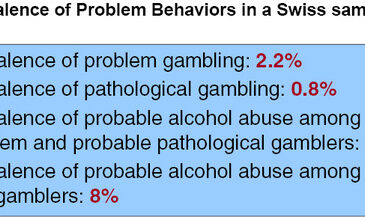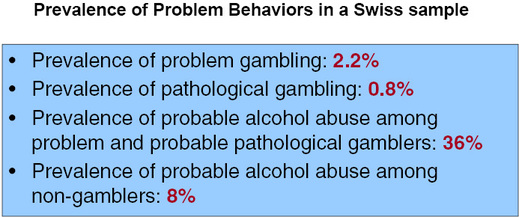The United States and Canada are not the only countries experiencing a rapid increase in the availability of legal gambling activities. Switzerland, too, has experienced an increase in its number of gambling opportunities. Bondolfi, Osiek, and Ferrero (2000) [1] conducted a telephone survey of 2,526 interviews. Researchers administered the SOGS to respondents, followed by the CAGE instrument. The CAGE is a four-question brief screen for alcohol abuse; a more detailed description is presented in WAGER 4(48).
The authors used the standard scoring scheme for the SOGS. A score of three or four indicates ‘problem gambling,’ while a score of five or more represents ‘probable pathological gambling.’ For the CAGE, subjects scoring two, three, or four were classified as probable alcohol abusers. The results of the Swiss study are presented at left.
The prevalence estimate for problem gambling falls within the 95% confidence interval established by Shaffer et al. However, the prevalence of pathological gambling falls outside the interval. Thus, while there is no statistically significant difference in the level of problem gambling between Swiss and American/Canadian samples, the level of pathological gambling is significantly lower. The difference in the prevalence of problem drinking between problem/pathological gamblers and non-gamblers is large; the former group is more than four times more likely to be probable alcohol abusers than the latter group. This difference provides additional support for higher levels of comorbidity among problem and pathological gamblers than among non-gamblers.
References
[1] Bondolfi, G., Osiek, C., & Ferrero, F. (2000). Prevalence estimates of pathological gambling in Switzerland. Acta Psychiatrica Scandinavica, 101, 473-475.





